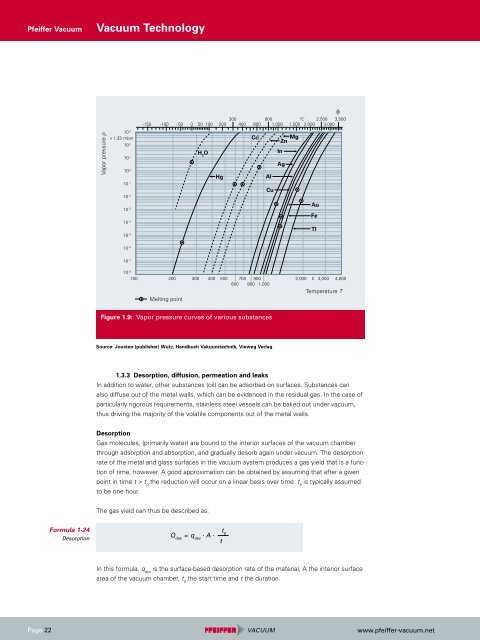Create successful ePaper yourself
Turn your PDF publications into a flip-book with our unique Google optimized e-Paper software.
Pfeiffer <strong>Vacuum</strong><br />
Page 22<br />
Formula 1-24<br />
Desorption<br />
<strong>Vacuum</strong> <strong>Technology</strong><br />
Vapor pressure p<br />
10<br />
x 1,33 mbar<br />
3<br />
10 2<br />
10 1<br />
10 0<br />
10 -1<br />
10 -2<br />
10 -3<br />
10 -4<br />
10 -5<br />
10 -6<br />
10 -7<br />
10 -8<br />
300 800 °C 2,500 3,500<br />
-150 -100 - 50 0 50 100 200 400 600 1,000 1,500 2,000 3,000<br />
H 2 O<br />
1.3.3 Desorption, diffusion, permeation and leaks<br />
In addition to water, other substances (oil) can be adsorbed on surfaces. Substances can<br />
also diffuse out of the metal walls, which can be evidenced in the residual gas. In the case of<br />
particularly rigorous requirements, stainless steel vessels can be baked out under vacuum,<br />
thus driving the majority of the volatile components out of the metal walls.<br />
Desorption<br />
Gas molecules, (primarily water) are bound to the interior surfaces of the vacuum chamber<br />
through adsorption and absorption, and gradually desorb again under vacuum. The desorption<br />
rate of the metal and glass surfaces in the vacuum system produces a gas yield that is a function<br />
of time, however. A good approximation can be obtained by assuming that after a given<br />
point in time t > t the reduction will occur on a linear basis over time. t is typically assumed<br />
0 0<br />
to be one hour.<br />
The gas yield can thus be described as:<br />
Q des = q des . A .<br />
In this formula, q des is the surface-based desorption rate of the material, A the interior surface<br />
area of the vacuum chamber, t 0 the start time and t the duration.<br />
Hg<br />
t<br />
t 0<br />
Cd<br />
Al<br />
Cu<br />
Mg<br />
Zn<br />
In<br />
Ag<br />
Au<br />
Fe<br />
100 200 300 400 500 700 900 2,000 K 3,000 4,000<br />
600 800 1,000<br />
Temperature T<br />
Melting point<br />
Figure 1.9: Vapor pressure curves of various substances<br />
Source: Jousten (publisher) Wutz, Handbuch Vakuumtechnik, Vieweg Verlag<br />
Tl<br />
�<br />
www.pfeiffer-vacuum.net

















